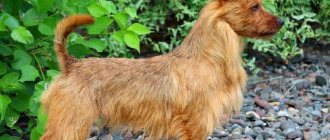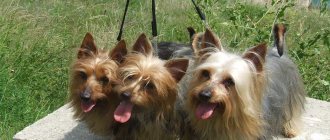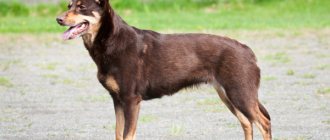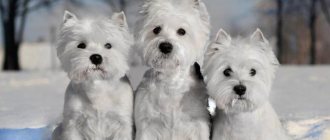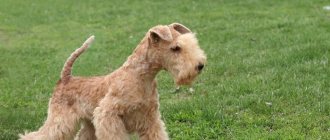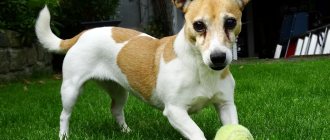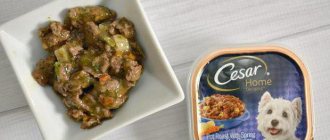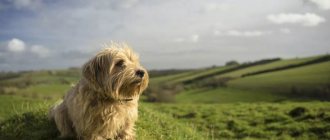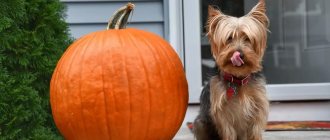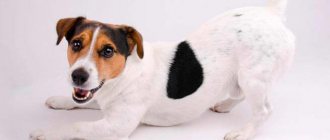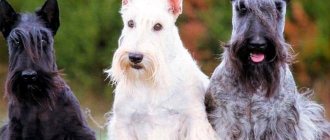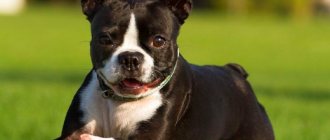The Australian Silky Terrier, also called the Silky, is very similar to the Yorkie. Its distinctive feature is its beautiful flowing coat. However, this is not just a decorative breed. At home, in Australia, these animals were used for protection and hunting. Modern Silk Terriers have retained all their working qualities, but their friendly and loyal nature has allowed them to become excellent companions. Let's find out who this breed is suitable for.
Story
Several representatives of the terrier group participated in the formation of the Australian Silky Terrier breed. In the 18th century, English colonists moved to Australia en masse, and they brought the breed there. People did not particularly care about the purity of the lines, they simply adapted the dogs to local conditions if possible.
The responsibilities of the four-legged pets became hunting, protecting the property and livestock of farmers, and catching rodents and poisonous snakes.
At the end of the 19th century, Yorkies arrived in Sydney, and local residents crossed them with Australian terriers. It was from the first that the new breed inherited its beautiful long hair. Otherwise, the snares turned out to be a smaller copy of their Australian ancestors. But even with improved appearance, the dog was considered a working dog.
The first mixed litters were not identified as a separate species: some puppies looked like Yorkies, others like Australians, and others were different from both. Further crossbreeding was carried out within the new dog breed until a stable type was developed.
In 1906, a standard was developed (later it was updated several times), and in 1907 the first Silkie Terrier breed was presented at an exhibition in Australia (and in Great Britain only in 1930).
The dogs came to the USA after World War II, where they gained enormous popularity and recognition. Until 1955, the species was called the Sydney Silky Terrier, but the American Canine Association renamed the dog.
The Silkie Terrier breed was officially registered in the USA in 1959.
Despite its popularity and attractiveness, the Silkie is a rare and expensive breed.
Interesting Facts
The Australian Silky Terrier is not the most popular breed. However, there are several interesting facts associated with it:
- The breed was originally called the Sydney Silky. The dog received its current name in 1955.
- The Silkie, Yorkshire Terrier and Australian Terrier were considered a single breed until 1929.
- In Evgeniy Abyzov’s film “The Understudy,” a snare girl named Sima starred. She also appeared in the series “Let's Wake Up Together” in the company of two other Australian Silky Terriers.
Description of the Silky Terrier
The dog's build is strong and dense, its legs are short. The movements of the snare are light, free and energetic. The breed belongs to the group of toy terriers, the main purpose is to be a companion.
Size
The height of the terrier at the withers is from 23 to 26 cm (males are larger). The dog's weight is 3.5-4.5 kg.
Head
The snare's skull is wedge-shaped (the length of the upper part of the head is longer than the muzzle), and is of medium size. Slightly flattened on top, the distance between the dog’s wedge-shaped erect ears is small (but there is a fold-eared variety).
The terrier's eyes are almond-shaped, small, dark. The look is attentive, piercing. The edges of the eyelids and nose are black. The transition to the forehead is moderate. The teeth of the snare are in line and have a scissor bite.
Body type
The dog's neck is medium, the scruff is pronounced. The topline is level. The chest is wide and deep. The terrier's body is moderately low and elongated. The tail is docked. Major defects are considered to be a dog's back curvature and short body.
Limbs
Straight, strong, moderately muscular. The angles of articulation of the elbows and knees are pronounced. The breed's paws are small and compact, with the toes pointing forward. The pads are elastic and thick.
Color
Blue, blue, with thick tan. Too light colors in the breed are unacceptable. The color starts from the scruff of the neck and extends to the tip of the tail, down to the elbows and knees of the dog.
Wool
Long, flowing, parted in the middle of the back. The axial hair is not hard, there is a soft undercoat. The hair is smooth to the touch. Shorter on the limbs.
Character and appearance
Despite their activity and temperament, dogs have a stable psyche and balance. Silks are distinguished by their fearlessness and pugnacity.
Dogs quickly become attached to their owners and get along with children. It is not recommended to own this breed of dog for people who lead a sedentary lifestyle, as terriers require frequent walks and vigorous exercise.
Expert opinion
Anna Abramenko
An avid dog lover. Experience in veterinary medicine since 2009.
Ask a Question
Silks willingly make contact with people, but as guards they are vigilant and incorruptible. Australian dogs are unobtrusive, know how to spend time on their own, and do not suffer from boredom.
Children who are too young can cause stress for a dog; a terrier can even bite in self-defense. But snares are friendly to pets, including cats with whom they live under the same roof.
Silk puppies are born almost black, but with age (up to 1.5 years) their color changes to blue or light blue.
If you do not show firmness and perseverance towards the Australian Terrier in time, then it will become dominant in the family, and the owners will have to fulfill its whims.
Education and training
You need to start training with a terrier from 2 months. The first skills are litter box training, walking on a leash, knowing a nickname. During lessons, a kind attitude towards the dog and rewards for success have a special effect. Early socialization is necessary, as the snare has a timid and shy character.
Such individuals are easy to train, distinguished by intelligence and excellent memory. But terriers quickly get tired of the monotony and begin to be stubborn, so different exercises need to be alternated more often. From puppyhood, Australian dogs require an authoritative attitude, as they are somewhat capricious.
Sometimes a dog is unable to overcome its hunting instincts - it gets distracted by birds, cats, sniffs out tracks, digs holes. When meeting with relatives, the terrier tries to take a leading position.
A restless pet needs active games, walks, jogging, and training. Otherwise, if kept passively for a long time, the Australian Terrier will begin to wither and get sick. Improper care will also affect the dog’s psyche – timidity or increased aggression will appear.
Australian Silky Terriers love to bark. They do it loudly, piercingly and for a long time.
Who is this dog suitable for?
The breed is suitable for people leading an active lifestyle. Snares for those who respect walks in the fresh air. The Silky Terrier is an alternative breed for people who like Yorkies, Cairns or Scottish Terriers.
The Australian “baby” will give everyone a head start. Silky is ideal for keeping in a city apartment, as it practically does not shed. It doesn't take up much space.
But for homebodies, phlegmatic people or busy people, such a silky dog will be a burden; it is not suitable for elderly people either. There is no need to get one for those who do not have the money and time to care for the silky coat of a pet.
Care and maintenance
Snares are not particularly demanding, and they are not difficult to care for. The terrier's long coat needs to be brushed 2-3 times a week. She is trimmed every 2-3 months. Excess hair around the eyes and on the ears of the dog is cut off.
It is recommended to bathe your pet 2-3 times a year and select exclusively soft, hypoallergenic shampoos. The dog is clean, so regular brushing is sufficient.
Expert opinion
Anna Abramenko
An avid dog lover. Experience in veterinary medicine since 2009.
Ask a Question
Up to 3 months, meals are three times a day, as they grow older, their frequency is reduced to 2, but the volume increases. Routine is very important for the Australian Terrier. When purchasing a puppy, you should ask the breeder what the animal was fed. You need to change your dog's diet gradually. Its basis is cereals, vegetables, lean meat.
Proven store-bought food or homemade products are suitable as food (but you cannot mix them at one time).
Cleaning the terrier's ears – once a week.
Aussie teeth are not prone to tartar or plaque buildup, but they should be examined regularly.
In the cold season, it is advisable for the terrier to wear overalls for walks.
Expert opinion
Anna Abramenko
An avid dog lover. Experience in veterinary medicine since 2009.
Ask a Question
The dog cannot be kept on a chain or in an enclosure, only in a house (apartment).
Breed characteristics
| Short description | |
| Origin: | Australia |
| Conditions of detention: | House with private territory, apartment |
| Purpose: | Companion dog, herding dog |
| Color: | Sand, red, blue, gray-blue with a steel tint |
| Wool length: | Average length 6-7 cm. |
| Adult dog size: | The height of females is 20-24 cm, males 22-26 cm, weight of males is approximately 5-6 kg, females 5-7 kg. |
| Average life expectancy: | 13-15 years old |
| Walk: | Can be kept as an apartment dog without walking, but for proper development - 2 times a day |
| Physical activity needs: | Average physical activity requirement (walking 1 to 3 hours per day) |
| Fédération Cynologique Internationale (FIC) classification: | Group 3: Terriers, Section 2: Small Terriers |
| Puppy price: | From 12,000 to 30,000 rubles |
Health
Among small dogs, the Silka has the highest performance and adaptability to the environment. The breed is also excellent in health, as it inherited good genetics from its ancestors.
Typical diseases for the terrier are diabetes, epilepsy, skin diseases, and thyroid problems. But they are rare in animals.
Expert opinion
Anna Abramenko
An avid dog lover. Experience in veterinary medicine since 2009.
Ask a Question
Taking care of your pet's health includes timely vaccinations, systematic examinations by a veterinarian, proper feeding and maintaining activity.
Approximate nutrition
In order for the coat to be beautiful and shiny, the dog must receive a complete diet. There are two types of food - natural and specialized food. In the first case, the Australian terrier eats only raw meat, offal, vegetables, and fermented milk.
It is important not to overfeed your pet, as it may become obese. Sometimes the dog develops allergies in the form of itching, dandruff, and redness of the skin. In this case, the dog must be on a strict diet.
A simpler feeding option is dry food. It must be at least super-premium level. Only such brands have a good composition with a high protein content. In cheap feeds, most of the feed consists of grains, which negatively affect the health of the animal.
Another option is holistic medicine. These foods do not contain grain, but they are not suitable for all dogs. Therefore, when choosing the type of food, you need to control the terrier’s reaction.
List of nicknames
It is better to choose a name for your pet that is sonorous, suitable for the temperament, but not long and easy to remember:
- Suitable nicknames for boys are:
- Archie, Charlie, Dick, Jack, Max;
- Sam, Barney, Bucks, Ace, Cujo, Flash, Hugh, Rocky, Leo, Mike;
- Nemo, Nick, Oscar, Umka, Twix, Hooch, Caesar, Elvis, Ian, Hulk.
- For girls:
- Gina, Bella, Maggie, Lady, Dina, Chelsea, Sophie;
- Astra, Alpha, Alice, Barbie, Gerda, Busya;
- Eva, Maya, Nyura, Puma, Ruby, Tuchka, Fiona, Coco;
- Ellie, Juno, Utah, Fanta.
You need to accustom your pet to its name as soon as it appears in the family.
Rules for choosing puppies
When buying a dog, you need to get to know the kids' parents. Ideally, these are active, healthy animals with good pedigrees and adequate behavior. It is desirable for Australian dogs to have championship titles, especially if the owner plans to participate in exhibitions with the pet.
The puppy itself should look reasonably well-fed, active, and non-aggressive. The baby's gaze should be clear. The fur is shiny and thick. It is important to match the external characteristics of the Australian Terrier breed.
The baby should not be taken away from the mother before 2 months.
Mating
Australian Terriers become sexually mature at 15-18 months. Males may mount plush toys or household items. In this case, the pet should not be encouraged, but scolding it is also wrong. A puppy in adulthood may not respond to a female.
It is recommended to do the first mating on the bitch’s second heat, preferably 15-20 days. The pets must be walked together and brought to the male dog’s territory, where he can feel his strength. In case of size discrepancy, the owners should help the dogs: hold them, turn them around, choose a convenient place.
Repeated mating is possible either on the same day or after a week.
Cost and where to buy
You can buy a dog for 15-60 thousand rubles. (price depends on the nursery and region). The best representatives of the breed from eminent parents are often sold for $1,200-2,000.
When buying a puppy on the market or from unknown people, the future owner runs the risk of taking a non-purebred or sick animal. The best option would be to contact a well-known kennel or a breeder who professionally breeds Silky Terriers. The conditions for keeping dogs must meet all hygienic requirements.
Reviews
Olga: “We bought a girl, 2 months old, she lives with us for half a year. She immediately became a family favorite. I quickly got used to the tray. Fortunately, the terrier hardly misbehaves and doesn’t chew shoes. Barks not as often as we were afraid. Loves to be in company, in the center of attention. I made friends with the cat, they communicate without conflicts. Sometimes it gets a little tiring with the activity, but overall the impression is positive, we don’t regret one bit that we chose it.”
Artem: “We bought our daughter an Australian puppy two years ago. We were worried that there would be difficulties in caring for the terrier, but in vain. We bathe him sometimes, brush him often, there is no hair on the sofas or carpets. The dog treats guests calmly and is sociable. An absolutely problem-free dog, and my daughter is so happy.”
Anastasia: “Silky is a good and devoted friend, he will never let you get bored. But it takes a lot of time. The terrier knows how to have fun on his own, but more often he looks for company. Constantly asks to go outside. He behaves restlessly. So if you don’t like unnecessary fuss, then the dog is not for you.”
Photo and video review
Having become familiar with the description and standards of the Silky Terrier in theory, you can proceed to viewing the photo gallery and video review.
Feeding options
You can feed your Silky Terrier premium or holistic dry food. Dry food is properly balanced and provides the dog’s body with useful substances. If desired, Silky can be fed natural food.
| Can | It is forbidden |
| Beef, chicken breast, turkey | Pork, lard, fat, sausages |
| Sea fish (fillet) | River fish |
| Beef by-products | Bird bones |
| Beef bones and cartilage | Sweet, flour, salty, smoked |
| Carrots, zucchini, pumpkin, broccoli | Cabbage, legumes, potatoes |
| Buckwheat and rice | Semolina and other cereals |
With a natural diet, you will need to add vitamin supplements and fish oil to your diet. It is highly undesirable to alternate natural and dry food.
